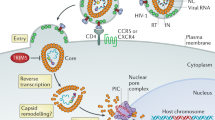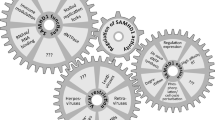Abstract
Several innate immune mechanisms exist in mammalian cells that prevent the replication of viruses. These cellular factors influence the tropism of retroviruses in mammalian cells by inducing a dominant restriction that acts after viral entry but before integration into the host genome. The identification of several cellular factors involved with the post entry block of HIV has recently been revealed. These recent advances identified the tripartite motif protein 5α (Trim5α) and the apolipoprotein B mRNA editing enzyme catalytic polypeptide-like 3G (APOBEC3G), which work to inactivate several retroviruses including HIV-1. The mechanism of restriction by these cellular proteins is unknown. Therefore, this review highlights recent advances in understanding the function of Trim5α and APOBEC3G.
Similar content being viewed by others
References and Recommended Reading
Gabuzda DH, Lawrence K, Langhoff E, et al.: Role of vif in replication of human immunodeficiency virus type 1 in CD4+ T lymphocytes. J Virol 1992, 66:6489–6495.
Simon JH, Gaddis NC, Fouchier RA, Malim MH: Evidence for a newly discovered cellular anti-HIV-1 phenotype. Nat Med 1998, 4:1397–1400.
Zheng YH, Lovsin N, Peterlin BM: Newly identified host factors modulate HIV replication. Immunol Lett 2005, 97:225–234.
Sheehy AM, Gaddis NC, Choi JD, Malim MH: Isolation of a human gene that inhibits HIV-1 infection and is suppressed by the viral Vif protein. Nature 2002, 418:646–650. This is a landmark paper identifying a cellular protein (CEM15) that obstructs HIV replication in restrictive cells without Vif. This study implies Vif improves virion infectivity by overcoming the antiviral activity of CEM15.
Jarmuz A, Chester A, Bayliss J, et al.: An anthropoid-specific locus of orphan C to U RNA-editing enzymes on chromosome 22. Genomics 2002, 79:285–296.
Mangeat B, Turelli P, Caron G, et al.: Broad antiretroviral defence by human APOBEC3G through lethal editing of nascent reverse transcripts. Nature 2003, 424:99–103. This report demonstrates that APOBEC3G exerts its antiviral activity through cytidine deamination. This activity was found to act on a broad range of retroviruses implying that APOBEC3G inhibits HIV-1 infection through hypermutation of the nascent cDNA.
Zhang H, Yang B, Pomerantz RJ, et al.: The cytidine deaminase CEM15 induces hypermutation in newly synthesized HIV-1 DNA. Nature 2003, 424:94–98.
Lecossier D, Bouchonnet F, Clavel F, Hance AJ: Hypermutation of HIV-1 DNA in the absence of the Vif protein. Science 2003, 300:1112.
Anderson JL, Hope TJ: HIV accessory proteins and surviving the host cell. Curr HIV/AIDS Rep 2004, 1:47–53.
Mariani R, Chen D, Schrofelbauer B, et al.: Species-specific exclusion of APOBEC3G from HIV-1 virions by Vif. Cell 2003, 114:21–31.
Yu Q, Konig R, Pillai S, et al.: Single-strand specificity of APOBEC3G accounts for minus-strand deamination of the HIV genome. Nat Struct Mol Biol 2004, 11:435–442.
Marin M, Rose KM, Kozak SL, Kabat D: HIV-1 Vif protein binds the editing enzyme APOBEC3G and induces its degradation. Nat Med 2003, 9:1398–1403.
Yu X, Yu Y, Liu B, et al.: Induction of APOBEC3G ubiquitination and degradation by an HIV-1 Vif-Cul5-SCF complex. Science 2003, 302:1056–1060.
Bishop KN, Holmes RK, Sheehy AM, et al.: Cytidine deamination of retroviral DNA by diverse APOBEC proteins. Curr Biol 2004, 14:1392–1396.
Wiegand HL, Doehle BP, Bogerd HP, Cullen BR: A second human antiretroviral factor, APOBEC3F, is suppressed by the HIV-1 and HIV-2 Vif proteins. Embo J 2004, 23:2451–2458.
Zheng YH, Irwin D, Kurosu T, et al.: Human APOBEC3F is another host factor that blocks human immunodeficiency virus type 1 replication. J Virol 2004, 78:6073–6076.
Harris RS, Liddament MT: Retroviral restriction by APOBEC proteins. Nat Rev Immunol 2004, 4:868–877.
Liddament MT, Brown WL, Schumacher AJ, Harris RS: APOBEC3F properties and hypermutation preferences indicate activity against HIV-1 in vivo. Curr Biol 2004, 14:1385–1391.
Newman EN, Holmes RK, Craig HM, et al.: Antiviral function of APOBEC3G can be dissociated from cytidine deaminase activity. Curr Biol 2005, 15:166–170. This important study reveals that the deaminase motif located in the C-terminus is the primary hypermutation domain and that the cytidine deamination activity of APOBEC3G can be separated from its antiviral activity.
Rosler C, Kock J, Malim MH, et al.: Comment on "Inhibition of hepatitis B virus replication by APOBEC3G." Science 2004, 305:1403.
Turelli P, Trono D: Editing at the crossroad of innate and adaptive immunity. Science 2005, 307:1061–1065.
Turelli P, Mangeat B, Jost S, et al.: Inhibition of hepatitis B virus replication by APOBEC3G. Science 2004, 303:1829.
Pincus T, Rowe WP, Lilly F: A major genetic locus affecting resistance to infection with murine leukemia viruses. II. Apparent identity to a major locus described for resistance to friend murine leukemia virus. J Exp Med 1971, 133:1234–1241.
Lilly F: Susceptibility to two strains of Friend leukemia virus in mice. Science 1967, 155:461–462.
Best S, Le Tissier P, Towers G, Stoye JP: Positional cloning of the mouse retrovirus restriction gene Fv1. Nature 1996, 382:826–829.
Benit L, De Parseval N, Casella JF, et al.: Cloning of a new murine endogenous retrovirus, MuERV-L, with strong similarity to the human HERV-L element and with a gag coding sequence closely related to the Fv1 restriction gene. J Virol 1997, 71:5652–5657.
Jolicoeur P, Rassart E: Effect of Fv-1 gene product on synthesis of linear and supercoiled viral DNA in cells infected with murine leukemia virus. J Virol 1980, 33:183–195.
Yang WK, Kiggans JO, Yang DM, et al.: Synthesis and circularization of N-and B-tropic retroviral DNA Fv-1 permissive and restrictive mouse cells. Proc Natl Acad Sci U S A 1980, 77:2994–2998.
Boone LR, Innes CL, Heitman CK: Abrogation of Fv-1 restriction by genome-deficient virions produced by a retrovirus packaging cell line. J Virol 1990, 64:3376–3381.
Bassin RH, Duran-Troise G, Gerwin BI, Rein A: Abrogation of Fv-1b restriction with murine leukemia viruses inactivated by heat or by gamma irradiation. J Virol 1978, 26:306–315.
Decleve A, Niwa O, Gelmann E, Kaplan HS: Replication kinetics of N-and B-tropic murine leukemia viruses on permissive and nonpermissive cells in vitro. Virology 1975, 65:320–332.
Boone LR, Glover PL, Innes CL, et al.: Fv-1 N-and Btropism-specific sequences in murine leukemia virus and related endogenous proviral genomes. J Virol 1988, 62:2644–2650.
Kozak CA, Chakraborti A: Single amino acid changes in the murine leukemia virus capsid protein gene define the target of Fv1 resistance. Virology 1996, 225:300–305.
DesGroseillers L, Jolicoeur P: Physical mapping of the Fv-1 tropism host range determinant of BALB/c murine leukemia viruses. J Virol 1983, 48:685–696.
Besnier C, Ylinen L, Strange B, et al.: Characterization of murine leukemia virus restriction in mammals. J Virol 2003, 77:13403–13406.
Towers G, Bock M, Martin S, et al.: A conserved mechanism of retrovirus restriction in mammals. Proc Natl Acad Sci U S A 2000, 97:12295–12299.
Towers G, Collins M, Takeuchi Y: Abrogation of Ref1 retrovirus restriction in human cells. J Virol 2002, 76:2548–2550.
Cowan S, Hatziioannou T, Cunningham T, et al.: Cellular inhibitors with Fv1-like activity restrict human and simian immunodeficiency virus tropism. Proc Natl Acad Sci U S A 2002, 99:11914–11919.
Besnier C, Takeuchi Y, Towers G: Restriction of lentivirus in monkeys. Proc Natl Acad Sci U S A 2002, 99:11920–11925.
Munk C, Brandt SM, Lucero G, Landau NR: A dominant block to HIV-1 replication at reverse transcription in simian cells. Proc Natl Acad Sci U S A 2002, 99:13843–13848.
Hofmann W, Schubert D, LaBonte J, et al.: Species-specific, postentry barriers to primate immunodeficiency virus infection. J Virol 1999, 73:10020–10028.
Owens CM, Yang PC, Gottlinger H, Sodroski J: Human and simian immunodeficiency virus capsid proteins are major viral determinants of early, postentry replication blocks in simian cells. J Virol 2003, 77:726–731.
Hatziioannou T, Cowan S, Goff SP, et al.: Restriction of multiple divergent retroviruses by Lv1 and Ref1. Embo J 2003, 22:385–394.
Goff SP: Retrovirus restriction factors. Mol Cell 2004, 16:849–859.
Stremlau M, Owens CM, Perron MJ, et al.: The cytoplasmic body component TRIM5alpha restricts HIV-1 infection in Old World monkeys. Nature 2004, 427:848–853. This landmark paper identifies Trim5α as the restriction factor responsible for inhibiting HIV-1 infection in primates and that this restriction is mediated by the retroviral capsid.
Reymond A, Meroni G, Fantozzi A, et al.: The tripartite motif family identifies cell compartments. Embo J 2001, 20:2140–2151.
Meyer M, Gaudieri S, Rhodes DA, Trowsdale J: Cluster of TRIM genes in the human MHC class I region sharing the B30.2 domain. Tissue Antigens 2003, 61:63–71.
Henry J, Mather IH, McDermott MF, Pontarotti P: B30.2-like domain proteins: update and new insights into a rapidly expanding family of proteins. Mol Biol Evol 1998, 15:1696–1705.
Hatziioannou T, Perez-Caballero D, Yang A, et al.: Retrovirus resistance factors Ref1 and Lv1 are species-specific variants of TRIM5alpha. Proc Natl Acad Sci U S A 2004, 101:10774–10779.
Keckesova Z, Ylinen LM, Towers GJ: The human and African green monkey TRIM5alpha genes encode Ref1 and Lv1 retroviral restriction factor activities. Proc Natl Acad Sci U S A 2004, 101:10780–10785.
Yap MW, Nisole S, Lynch C, Stoye JP: Trim5alpha protein restricts both HIV-1 and murine leukemia virus. Proc Natl Acad Sci U S A 2004, 101:10786–10791.
Perron MJ, Stremlau M, Song B, et al.: TRIM5alpha mediates the postentry block to N-tropic murine leukemia viruses in human cells. Proc Natl Acad Sci U S A 2004, 101:11827–11832.
Sawyer SL, Wu LI, Emerman M, Malik HS: Positive selection of primate TRIM5alpha identifies a critical species-specific retroviral restriction domain. Proc Natl Acad Sci U S A 2005, 102:2832–2837. This fascinating study identifies a 13 amino acid domain within the SPRY domain responsible for species-specific restriction of Trim5α by phylogenetic analysis. These results were then confirmed by experimental analysis.
Stremlau M, Perron M, Welikala S, Sodroski J: Species-specific variation in the B30.2(SPRY) domain of TRIM5alpha determines the potency of human immunodeficiency virus restriction. J Virol 2005, 79:3139–3145.
Luban J, Bossolt KL, Franke EK, et al.: Human immunodeficiency virus type 1 Gag protein binds to cyclophilins A and B. Cell 1993, 73:1067–1078.
Schmid FX: Prolyl isomerases. Adv Protein Chem 2001, 59:243–282.
Franke EK, Yuan HE, Luban J: Specific incorporation of cyclophilin A into HIV-1 virions. Nature 1994, 372:359–362.
Gamble TR, Vajdos FF, Yoo S, et al.: Crystal structure of human cyclophilin A bound to the amino-terminal domain of HIV-1 capsid. Cell 1996, 87:1285–1294.
Yoo S, Myszka DG, Yeh C, et al.: Molecular recognition in the HIV-1 capsid/cyclophilin A complex. J Mol Biol 1997, 269:780–795.
Thali M, Bukovsky A, Kondo E, et al.: Functional association of cyclophilin A with HIV-1 virions. Nature 1994, 372:363–365.
Braaten D, Franke EK, Luban J: Cyclophilin A is required for an early step in the life cycle of human immunodeficiency virus type 1 before the initiation of reverse transcription. J Virol 1996, 70:3551–3560.
Towers GJ, Hatziioannou T, Cowan S, et al.: Cyclophilin A modulates the sensitivity of HIV-1 to host restriction factors. Nat Med 2003, 9:1138–1143.
Sayah DM, Sokolskaja E, Berthoux L, Luban J: Cyclophilin A retrotransposition into TRIM5 explains owl monkey resistance to HIV-1. Nature 2004, 430:569–573. This novel study identifies a retrotransposition event where the Cyclophilin A gene was inserted into the Trim5α gene leading to the formation of the Trim5-CypA fusion protein. This fusion protein was found to be responsible for the restriction of HIV-1 in owl monkey cells.
Author information
Authors and Affiliations
Corresponding author
Rights and permissions
About this article
Cite this article
Perez, O., Hope, T.J. Cellular restriction factors affecting the early stages of HIV replication. Curr HIV/AIDS Rep 3, 20–25 (2006). https://doi.org/10.1007/s11904-006-0004-3
Issue Date:
DOI: https://doi.org/10.1007/s11904-006-0004-3




